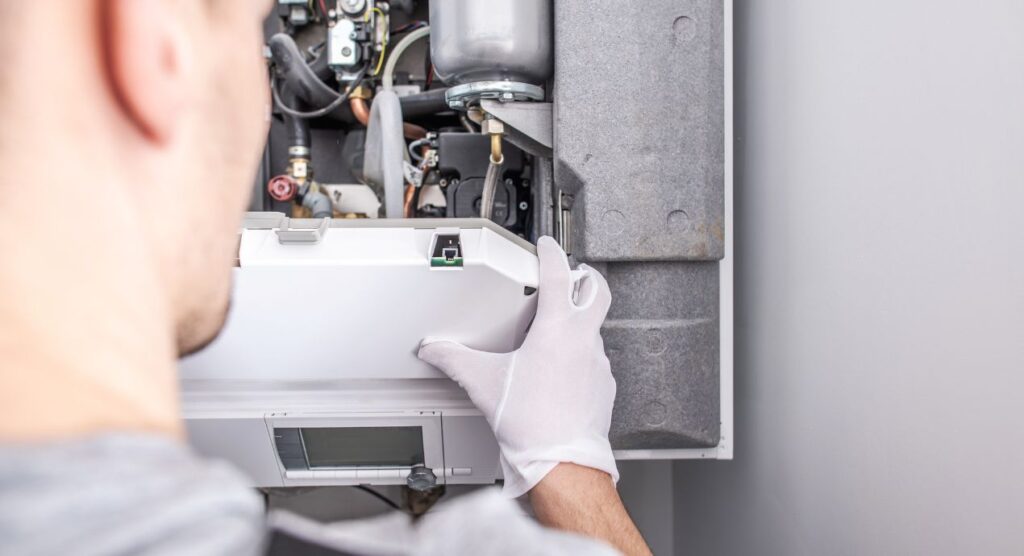The temperature outside plummets to 15 degrees, snow blankets your driveway, and suddenly your house feels uncomfortably cold. You check the thermostat—it’s set to 72 degrees, but the display shows your home’s actual temperature dropping steadily. Your heating system has failed at the worst possible moment.
This scenario plays out thousands of times each winter across American homes. According to the U.S. Energy Information Administration, space heating accounts for about 42% of energy use in typical homes, making your heating system one of your most critical home components. When it fails, the consequences extend far beyond mere discomfort.
Understanding how to respond to heating system emergencies, recognize warning signs of impending failure, and make informed decisions about repairs can save you money, prevent property damage, and keep your family safe. Whether you’re dealing with a complete system breakdown or subtle signs that something isn’t right, knowing what steps to take makes all the difference.
Recognizing the Warning Signs Before Complete Failure
Unusual Sounds and Their Meanings
Your heating system communicates through sounds, and learning this language can prevent emergencies. Banging noises often indicate loose or broken internal components, while grinding sounds suggest motor bearing problems. Whistling might point to airflow restrictions, and clicking sounds could signal electrical issues.
Sharp metallic sounds deserve immediate attention, as they often indicate components rubbing against each other due to loose mounting or worn parts. These problems rarely resolve themselves and typically worsen without intervention.
Performance Changes That Signal Problems
Heating systems rarely fail without warning. Gradual changes in performance often precede complete breakdowns. If your system takes longer to warm your home, cycles on and off more frequently, or struggles to maintain consistent temperatures, these symptoms indicate developing problems.
Uneven heating throughout your home might suggest ductwork issues, blocked vents, or system sizing problems. Previously comfortable rooms but now feel drafty or overheated point to system imbalances that need professional attention.
Rising Energy Bills as an Early Indicator
Sudden increases in heating costs often signal efficiency problems. When heating systems develop problems, they work harder to maintain desired temperatures, consuming more energy in the process. Comparing your current energy usage to previous years can reveal trends that indicate developing issues.
Systems operating at reduced efficiency not only cost more to run but also experience accelerated wear on components. Addressing efficiency problems early often prevents more expensive repairs later.
Emergency Response: What to Do When Your Heat Goes Out
Immediate Safety Considerations
When your heating system stops working, safety takes priority over comfort. If you smell gas near your furnace or throughout your home, evacuate immediately and contact your gas company. Never attempt to locate gas leaks yourself or use open flames to provide light in areas where gas might be present.
For electric systems, check your electrical panel for tripped breakers. However, avoid repeatedly resetting breakers that continue tripping, as this often indicates electrical problems that require professional diagnosis.
Temporary Heating Solutions
While waiting for professional repair, focus on containing heat in occupied areas of your home. Close doors to unused rooms, open curtains on sunny days to capture solar heat, and use ceiling fans on low speed to circulate warm air that naturally rises to ceiling level.
Space heaters can provide temporary relief but require careful use. Keep them away from flammable materials, never use them in bathrooms or other wet areas, and avoid running multiple units on the same electrical circuit. Electric blankets and extra clothing layers help maintain body warmth without overloading electrical systems.
Preventing Frozen Pipes
Water pipes become vulnerable when home temperatures drop below 50 degrees. Open cabinet doors under sinks to allow heated air to reach pipes running through exterior walls. Let faucets drip slightly to keep water moving through pipes, as flowing water is less likely to freeze than standing water.
If you have a basement or crawl space, check that foundation vents remain closed during the winter months. These vents are designed to provide summer ventilation but should be sealed when temperatures drop to prevent cold air from entering areas containing plumbing.
Understanding Different Types of Heating System Failures
Furnace-Specific Problems
Gas furnaces face unique challenges related to combustion and venting systems. Blocked exhaust vents can cause safety shutdowns, while dirty burners affect heating efficiency. Heat exchanger problems represent serious safety concerns that require immediate professional attention.
Pilot light issues in older furnaces might seem minor, but they often indicate gas flow problems or thermocouple failures. Modern furnaces with electronic ignition systems eliminate pilot lights but introduce electrical components that can fail and prevent system operation.
Heat Pump Complications
Heat pumps operate differently from traditional furnaces and face distinct challenges. During extremely cold weather, heat pumps may struggle to extract sufficient heat from outdoor air, causing them to run continuously without adequately warming your home.
Ice buildup on outdoor units is normal during certain weather conditions, but excessive ice that doesn’t melt during defrost cycles indicates problems. Heat pumps also rely on refrigerant systems that can develop leaks, reducing heating capacity and potentially damaging compressors.
Boiler and Radiator Issues
Hot water and steam heating systems present their own set of potential problems. Low water levels in boilers can cause overheating and safety shutdowns. Air trapped in radiator systems prevents proper heat distribution and creates banging noises.
Circulator pumps in hot water systems can fail, preventing heated water from reaching radiators throughout your home. These pumps operate quietly when functioning properly, so unusual noises often indicate bearing problems or electrical issues.
The Role of Professional Heating Repair Services
Advanced Diagnostic Capabilities
Professional heating repair technicians use sophisticated diagnostic equipment to identify problems quickly and accurately. Digital multimeters measure electrical voltages and currents, gas pressure gauges ensure proper fuel delivery, and combustion analyzers verify safe and efficient operation.
Thermal imaging cameras can detect heat loss, blocked ducts, and electrical hot spots that aren’t visible during standard inspections. These tools allow technicians to identify root causes rather than just treating symptoms.
Comprehensive System Knowledge
Experienced repair services like NexAir Home Services understand the intricate relationships between different system components. They recognize how problems in one area can affect other parts of your heating system and can predict which components might fail next based on current symptoms.
This comprehensive understanding prevents incomplete repairs that temporarily restore heat but leave underlying problems unresolved. Professional technicians also stay current with manufacturer updates, recalls, and common issues affecting specific equipment models.
Safety Protocol Compliance
Heating systems involve potentially dangerous elements, including natural gas, high-voltage electricity, and carbon monoxide. Professional technicians follow established safety protocols that protect both your family and your property during repairs.
These protocols include proper ventilation during repairs, gas leak testing after any gas line work, and electrical safety measures that prevent fires or electrocution. Professional repair services also carry insurance that protects homeowners if accidents occur during repair work.
Making Smart Decisions About Heating Repairs
Repair Versus Replacement Considerations
Age plays a significant role in repair decisions. Systems approaching 15-20 years old might benefit more from replacement than expensive repairs, especially if efficiency standards have improved significantly since installation.
Frequency of repairs also matters. Systems requiring multiple service calls each season often indicate that major components are nearing end-of-life. The cumulative cost of frequent repairs can exceed replacement costs while providing less reliable heating.
Energy Efficiency Improvements
Modern heating systems offer substantially better efficiency than units installed even ten years ago. High-efficiency furnaces can reduce heating costs by 20-30% compared to older models, and heat pumps have become viable options in colder climates thanks to technological improvements.
Programmable and smart thermostats can improve efficiency regardless of your heating system type. These devices optimize heating schedules based on occupancy patterns and can reduce energy consumption by 8-10% annually.
Preventive Maintenance: Your Best Defense Against Breakdowns
Regular Filter Changes
Clean air filters ensure proper airflow through your heating system. Dirty filters restrict airflow, forcing your system to work harder and potentially causing overheating in furnaces or reduced heat output in heat pumps.
Filter replacement frequency depends on your system type, indoor air quality, and household factors like pets or smoking. Most systems benefit from monthly filter checks, with replacement every 1-3 months depending on conditions.
Annual Professional Maintenance
Professional maintenance services provide comprehensive system inspections that identify potential problems before they cause breakdowns. Technicians clean components, test safety controls, verify proper operation, and make minor adjustments that improve efficiency.
Maintenance contracts often include priority emergency service and discounts on repairs. These programs can provide peace of mind and cost savings, especially for older heating systems that require more attention.
Taking Action When Your Heating System Needs Help
Heating repair services address problems quickly and effectively, combining professional expertise, proper tools, and strict safety protocols to restore comfort while preventing minor issues from escalating into costly emergencies.
Don’t wait until your heating system fails during the coldest day of winter. If you notice any warning signs or your system isn’t performing as efficiently as usual, contact qualified professionals who can diagnose problems accurately and recommend appropriate solutions.
Your family’s comfort and safety depend on a reliable heating system. Professional heating repair services provide the expertise and reliability you need to keep your home warm throughout the heating season.







